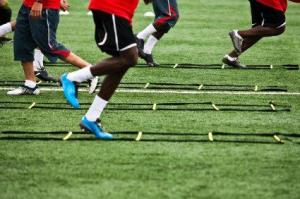Charlotte Athletes: The Big Strength Training Secret
Put the Barbells Away
That’s right. Even the light weights. If you are a young athlete, you have...
By: admin Jun 11, 2023 1:56:38 PM
Some people, even some incredibly cut gym rats, still think they’re doing sports performance training when they curl and bench press.
No mirrors in this training facility
But there are some huge differences between working out or executing a fitness routine and sports performance training. The latter uses prescribed drills and exercises with one goal in mind–maximizing athletic potential.
It’s this targeted approach to physical and physiological progression that makes the difference. In sports performance training there is little to no static stretching. Instead, athletes warm up dynamically, incorporating functional movement. And the training sessions are so much more detailed. It’s not just lower body one day and upper the next.
Coaches vs. Personal Trainers
There are very specific protocols. So specific, in fact, that many times the coaches carry “cheat sheets” in their pockets. But that just proves how critical it is to deliver the training system the way it was scientifically designed. Each exercise or drill is selected to follow in an evidence-based order to achieve the desired results–mainly increased speed, strength and power. Muscles have something called motor unit synchronization which means that muscles need to fire in the proper order to maximize speed and power.
Performance vs. Fitness
Explosiveness is generally not a part of a traditional work out. But it is critical to every sport–from the swimmer diving off the block to the volleyball player jumping for a block. Plus, serious athletes need other skills to make them competitive and reduce the risk of injury:
Over the next few weeks I’ll be discussing each of the above sports performance components in more depth. It helps to understand why we train in a certain way. The importance of each and how all of them work together to transform an athlete’s performance from good to record-breaking. Staying on top of your game–that’s what it’s all about–and it simply won’t happen if you’re just working out.
Put the Barbells Away
That’s right. Even the light weights. If you are a young athlete, you have...
“How do I get more explosive?” That’s a question that pops up over and over again in my 9+ years of...
You’re standing there on the starting line ready to run a max effort sprint for time…for football...